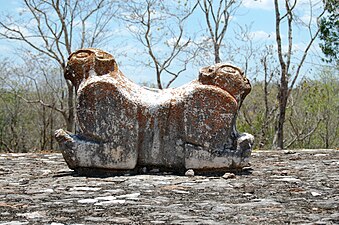Jaguar throne
As Jaguar throne a ruler seat is Maya prince called. These thrones were found in several Mayan ruin sites. They are available in one and two-headed versions.
Meaning of the jaguar
One of the most important animal gods of the Maya was the jaguar . This lithe and dangerous big cat served them as a symbol of royal power and was therefore particularly revered. For the Maya, the jaguar was also a symbol of the sun in the Xibalba underworld , associated with death and sacrifice. Already in Olmec reliefs one can possibly recognize the copulation of a jaguar with a human woman, from which characteristic beings originated that are regarded as who- jaguars . In the early Olmec culture, jaguar claws or teeth were considered symbols of supernatural powers. The Aztecs equated the jaguar with an embodiment of their god Tezcatlipoca . From Teotihuacán , the jaguar cult spread far across Central America . In mythology, the jaguar, as an animal of the night, devours the sun. The Chilam Balam ("jaguar priest" and the priests' records) also point to the great importance of the jaguar.
Locations
In Uxmal there is a jaguar throne with a head on each side in front of the so-called governor's palace. In Chichén Itzá there were several, one of which is in the lower Jaguar temple and another was found inside the pyramid of Kukulcán . In Palenque there is also a picture of a ruler on a jaguar throne.
Picture gallery
K'inich Janaab 'Pakal I on the Jaguar throne in Palenque
literature
- Marcia Castro Leal: Archeology in Mexico. Bonechi (Original. Monclem Editiones), Florence 1990, ISBN 968-6434-03-8 .
- Nicholas J. Saunders: Jaguars and Pumas. in: Oxford Encyclopedia of Mesoamerican cultures. Oxford University Press, Oxford 2001, ISBN 0-19-510815-9 . Volume 2, pp. 66-68.
- David M. Jones, Brian L. Molyneaux: Mythology of the New World: The Encyclopedia of Myths in North, Meso and South America. Anness Publishing Limited, 2001, ISBN 3-89736-313-5 .
Web links
- Jaguar thrones. on archeology.about.com (English)
- The Jaguar Throne. on americanegypt.com (English)
Individual evidence
- ↑ Section Chaak Balam on angelfire.com, accessed 29 February 2012.
- ↑ Mythology of the New World: The Encyclopedia of Myths in North, Meso and South America. ISBN 3-89736-313-5 . P. 117.
- ^ Marcia Castro Leal: Archeology in Mexico. Bonechi (Original. Monclem Editiones). Florence 1990, ISBN 968-6434-03-8 . (German edition: p. 93).



